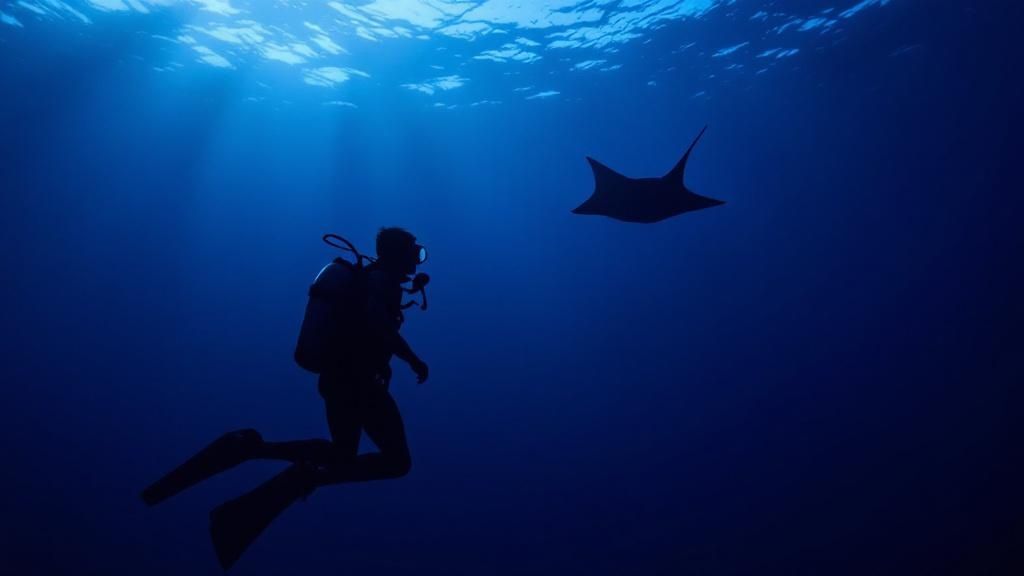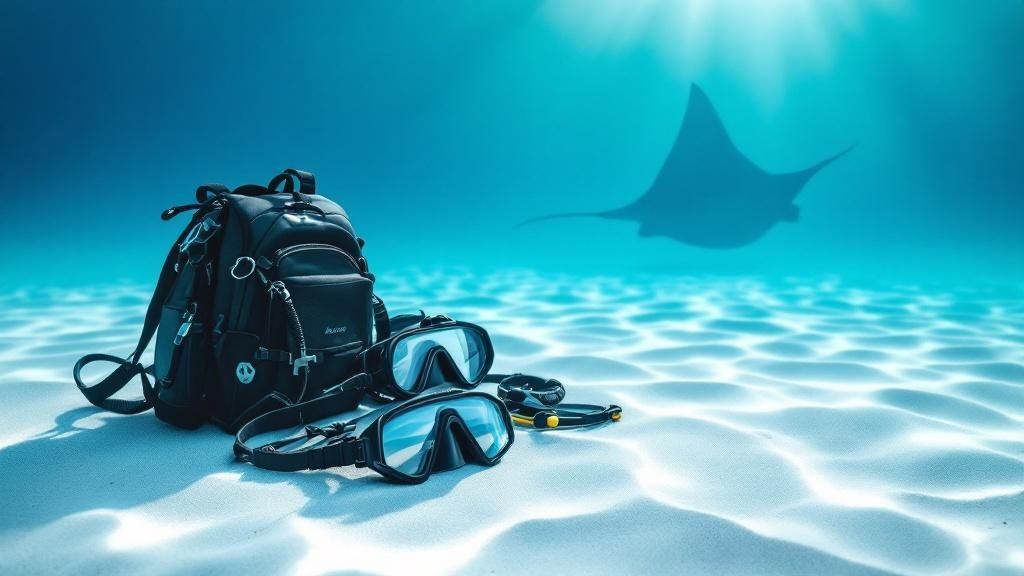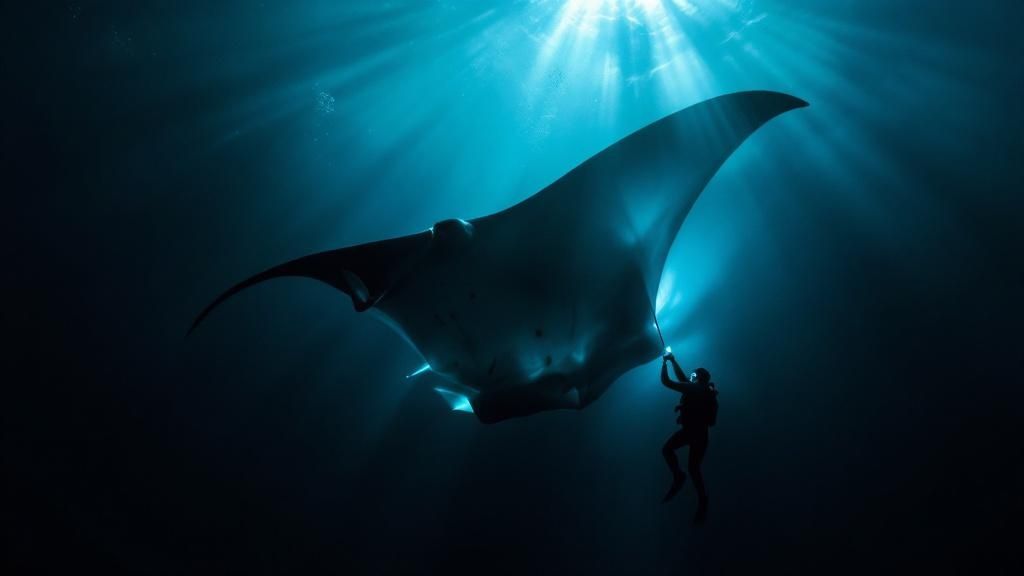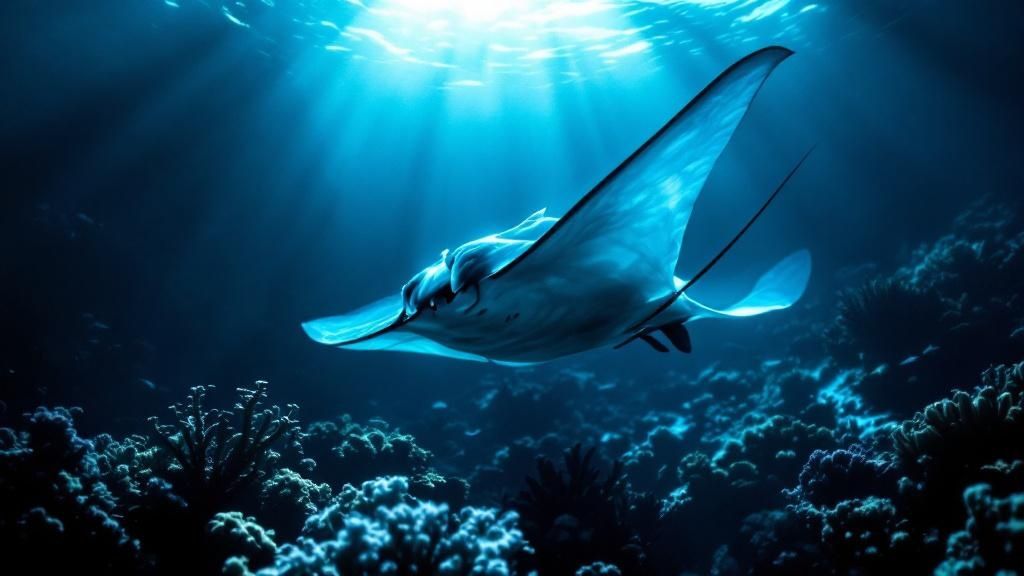Picture this: you’re weightless in the dark, warm waters of the Pacific. Suddenly, a giant, graceful shadow with a wingspan wider than you are tall glides just inches over your head, performing a silent, hypnotic ballet. This isn't a scene from a movie; it's the world-famous Kona manta ray night dive, and it’s an experience that puts the Big Island on every diver's bucket list.
What Makes the Kona Manta Ray Dive So Unique?

The magic of the Kona coast comes down to one simple thing: a brilliant, man-made feeding ritual. Tour boats head out each night and shine powerful lights into the water. These lights act like a massive bug zapper for the ocean, attracting swarms of microscopic plankton. For the local manta rays, this is basically a reliable, all-you-can-eat buffet.
This clever setup is why the experience is so consistent. It’s what brings in roughly 80,000 people a year for night dives and snorkels, making Kona one of the most reliable places on Earth to see these animals up close.
At famous sites like "Manta Village" and "Manta Heaven," it's not uncommon to be surrounded by 8-12 different rays in a single evening. That level of predictability is what truly sets the Kona manta ray experience apart from anywhere else in the world.
You have two main ways to join the show, each offering a totally different perspective:
- Scuba Diving: If you're a certified diver, you get a front-row seat. You'll descend to the sandy bottom, get comfortable, and point your flashlight up. The mantas then swoop and perform barrel rolls right over your head to scoop up the plankton concentrated in your light beam.
- Snorkeling: Not a diver? No problem. Snorkelers float on the surface, holding onto a custom light board that illuminates the water below. From here, you get an incredible bird's-eye view of the entire spectacle as the mantas feed just beneath you.
It doesn't matter if you're watching from the seafloor or floating on the surface—the feeling is the same. There's a profound sense of awe that comes from being so close to these gentle giants. Their sheer size and effortless grace create a peaceful, almost surreal atmosphere that stays with you long after you've dried off.
Figuring out which option is right for you is the first step. To get a better feel for the whole operation, you can learn more about what to expect from a manta ray night dive.
Choosing Your Manta Ray Adventure

When you’re planning a manta ray encounter in Kona, the biggest decision you'll make is how you want to see the show. Think of it like a concert: do you want the bird's-eye view from the balcony, or do you want to be right in the front row, feeling the energy up close?
This choice boils down to snorkeling versus scuba diving, and each one offers a completely different—but equally magical—perspective.
Snorkel vs Scuba How to Choose Your Manta Encounter
Not sure which option is right for you? This side-by-side comparison can help you find the perfect manta ray experience for your comfort and skill level.
| Feature | Snorkeling | Scuba Diving |
|---|---|---|
| Viewpoint | Top-down aerial view from the surface. | Bottom-up view from the ocean floor. |
| Experience | Floating and holding onto a light board that attracts plankton, drawing mantas just below you. | Sitting or kneeling peacefully on a sandy bottom as mantas glide and barrel roll directly overhead. |
| Depth | On the surface. | Typically 30-35 feet deep. |
| Requirements | Basic swimming ability. No prior experience is needed, making it great for families and non-divers. | Must be a certified scuba diver. |
| Proximity | Mantas can come within feet of you, just under the surface. | Often closer, with mantas sometimes soaring just inches above your head. |
| Best For | Anyone! It's accessible, exciting, and gives a fantastic overview of the entire feeding "ballet." | Certified divers seeking a truly immersive and peaceful encounter. |
Ultimately, both snorkeling and diving deliver an unforgettable night. The "best" choice is the one that lets you relax and fully soak in the moment.
Picking Your Dive Site
Next up is choosing your location. Kona has two main hotspots for manta rays, and each has its own vibe.
-
Manta Village (Keauhou Bay): This is the go-to spot for reliability. The conditions are usually calmer, and the sandy bottom makes it feel very accessible. If you're a first-timer or a bit anxious about a night snorkel or dive, this is a fantastic choice.
-
Manta Heaven (Garden Eel Cove): A bit more rugged, this site can sometimes have stronger currents and is a touch deeper. The payoff? It’s famous for attracting huge congregations of mantas, making it a favorite for seasoned divers looking for a truly epic show.
No matter which adventure you pick, it’s an experience that will stick with you forever. Understanding what makes this a true bucket-list activity can help you get the most out of it; you can learn more about why you should go on a manta ray dive in Kona.
Of course, a great tour is just one part of a great trip. Applying some general trip planning tips will help ensure every detail is sorted out, leaving you free to just enjoy the magic.
How to Prepare for Your Night Dive

A great manta ray dive doesn’t just happen when you hit the water—it starts with what you do before you even leave the dock. A little bit of prep work ensures you're comfortable and warm, so your full attention can be on the incredible ballet unfolding beneath the waves.
The biggest secret to a comfortable night dive? Staying warm. Even in tropical Hawaii, the ocean at night combined with the boat ride back to shore can leave you feeling chilled. A simple dry bag with your essentials is your best friend here.
Trust me, this one small step makes a world of difference. When you're not shivering, you can truly soak in every amazing moment of the experience.
Your Essential Packing List
While we handle all the heavy-duty dive gear, a few personal items are key to your comfort. Here’s a quick list of must-haves for your adventure:
- A Big, Warm Towel & Dry Clothes: This is non-negotiable. Having a fluffy towel and a dry hoodie or windbreaker to slip into after the dive makes the ride home so much better.
- Motion Sickness Remedy: If you’re even a tiny bit susceptible to seasickness, take your preferred remedy before getting on the boat. Don’t let a queasy stomach spoil the magic.
- Reusable Water Bottle: It’s easy to get dehydrated, even on a short trip. Bring some water to sip.
- Reef-Safe Sunscreen: Yes, for a night dive! The boat ride out happens while the sun is still setting, so it's smart to apply some beforehand.
Expert Tip: The single most important part of your preparation is to listen carefully during the pre-dive briefing. Your guide will cover vital safety info and the "manta manners" you'll need for a respectful and safe encounter.
For a more detailed look at gear, check out our guide on the gear you will need for your Kona diving adventure. Being prepared allows you to simply relax and let the underwater magic take over.
What to Expect in the Water

After a quick boat ride and a solid safety briefing from your crew, it’s time. Slipping into the dark, surprisingly warm Pacific waters is a feeling you won’t forget—it’s where the magic begins.
Your guide will lead the group to a specific spot where the show is about to unfold. If you’re a scuba diver, you’ll descend to the sandy ocean floor, usually around 30-35 feet, and find a place to settle in. Snorkelers get a front-row seat from the surface, holding onto a custom float board that has bright lights pointing down into the depths.
This whole setup is designed to create what we call an "underwater campfire." The powerful lights, whether from the dive site below or the snorkel boards above, slice through the darkness. This light attracts huge clouds of plankton, which just so happens to be a manta ray’s favorite meal. It's an ingenious, simple, and incredibly effective way to create a reliable feeding zone, turning the ocean into a five-star restaurant for these gentle giants.
The Grand Entrance
At first, there’s nothing but the beams of your lights cutting through the inky black water. Then, you’ll spot a shadow moving at the edge of the light. It gets bigger, and a distinct shape emerges—a graceful giant with a wingspan that can easily stretch over 12 feet.
Before you know it, another one glides into view, and then another. They move effortlessly into the illuminated buffet, starting a silent, mesmerizing feeding ballet. The mantas perform incredible barrel rolls and graceful somersaults, swooping through the clouds of plankton with their huge mouths wide open.
They are completely absorbed in their dinner, often gliding just inches over the heads of the scuba divers or right below the snorkelers at the surface. It's a remarkably peaceful and humbling experience; you're just a quiet observer as these magnificent creatures take center stage.
The feeling is almost impossible to put into words. It's a mixture of pure awe and a deep sense of peace, watching these massive animals move with such impossible grace. There's no sound, just a silent, hypnotic dance playing out right in front of you.
The entire time you're in the water usually lasts about 30 minutes, but it feels like a lifetime of memories packed into a single, breathtaking encounter. For a more personal take, check out these firsthand accounts of what it’s like to go on the manta ray dive in Kona. It’s a truly unique manta ray dive kona experience you have to see to believe.
Manta Manners: Your Guide to a Safe and Respectful Encounter
Getting to swim with manta rays in the wild is an absolute privilege. When you join a manta ray dive kona, you're stepping into their world, and it's on us to be good guests. That’s where a simple code of conduct, known as “Manta Manners,” comes in. Following these guidelines is what keeps the mantas safe and ensures this incredible experience will be around for decades to come.
The number one rule is the most important: look, but never touch. This isn't just a friendly suggestion—it’s a critical rule that protects the mantas. Their skin is covered by a delicate, protective slime coat that acts as a shield against bacteria and parasites. If you touch them, even by accident, you can rub off that protective layer, leaving them vulnerable to serious infections.
Your job is to simply be a calm, quiet observer. When you float peacefully, you let the mantas take the lead. They are incredibly curious animals and will often glide within inches of you, completely on their own terms. The best thing you can do is just float, watch, and let the magic happen.
How Responsible Tourism Protects the Mantas
Your behavior in the water is half the equation; choosing the right tour operator is the other half. Make sure you book with a company on the Manta Ray Green List. These are the operators who have proven their commitment to sustainable, respectful wildlife encounters. They take the time to educate divers and snorkelers, and they stick to strict guidelines that minimize their environmental footprint.
By supporting these businesses, you're directly contributing to the preservation of the Kona coast's unique ecosystem. It also helps fund the vital research needed to protect these creatures. For example, comprehensive studies between 2009 and 2014 tracked individual manta sightings, which gave scientists a treasure trove of data on the population's health and travel patterns. This massive effort, built on thousands of recorded encounters, is what cemented Kona's reputation as a world leader in both manta research and responsible ecotourism. You can discover more about how this research supports manta conservation.
Following Manta Manners is about more than just a single dive. It's a collective responsibility to ensure that future generations can witness the same underwater magic we are so fortunate to experience today.
Answering Your Kona Manta Ray Dive Questions
It's completely normal to have a few questions swirling around before you book your trip, even with all the excitement. Getting clear answers will help you feel totally confident and ready for the amazing experience ahead. Let's tackle some of the most common questions we hear from divers and snorkelers.
Are Manta Ray Sightings Guaranteed?
This is probably the number one question we get. While manta rays are wild animals and we can never make a 100% guarantee, the success rate here on the Kona coast is incredibly high—often over 90%. The dive sites are well-established feeding grounds that the mantas visit almost every single night.
On the rare occasion that the mantas decide not to show, most reputable companies offer a "manta guarantee." This usually means you can come back another night for free. It’s a great reason to book your manta dive early in your vacation, giving you a backup night just in case.
Is There a Specific Manta Ray Season in Kona?
Great question, and the answer is even better: nope! The manta rays here are residents, not tourists. They don't migrate, which means you can find them gracing our waters every single month of the year.
That said, ocean conditions do change. The summer months, typically from April to October, tend to bring calmer seas and warmer water. This can make the whole experience, especially for snorkelers on the surface, just a bit more comfortable.
Are Manta Rays Dangerous?
Not at all! It’s an easy mistake to make, especially since they look a bit like their stingray cousins. Manta rays are true gentle giants. They have no stingers, no barbs, and no teeth. They're filter feeders, so their entire diet is made up of tiny plankton they scoop from the water.
Mantas are completely harmless to people. They might get impressively close, but it’s only because they're curious and focused on swooping in to get the plankton gathered by our lights. You’re simply an observer in their world, not part of the food chain.
The most important thing to remember is that while they aren't dangerous to us, we can be to them. The "look, but don't touch" rule is absolute. Touching their skin can remove its protective slime coat, leaving them vulnerable to infection.
Trying to figure out all the logistics can feel like a lot, but seeing a detailed breakdown of the manta ray night dive of Kona with Kona Honu Divers can give you a clear picture of what a world-class tour actually looks like.
